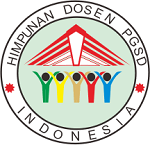MENINGKATKAN HASIL BELAJAR IPA MATERI LINGKUNGAN HIDUP MELALUI METODE EXAMPLES NON EXAMPLES PADA SISWA KELAS X IPA 1 SMA NEGERI 9 PEKANBARU TAHUN AJARAN 2018
DOI:
https://doi.org/10.24114/jgk.v5i3.25628Abstract
Abstract: Improving Environmental Science Learning Outcomes Through The Examples Non Examples Method In Students Of Class X IPA 1 SMA Negeri 9 Pekanbaru 2018 Academic Year. This study aims to determine whether there are differences in student learning outcomes using examples non-examples learning models with conventional learning models, specifically on environmental materials. The research conducted by the researcher is an experimental study using a research design in the form of a quasi-experimental design. Quasi experimental design is a development of true experimental design. The population in this study were all students of class X IPA.1 SMA Negeri 9 Pekanbaru. In this study, researchers used a sampling technique, namely non-probability sampling. The non-probability sampling technique that will be used is saturated sampling. Saturated sampling is a sampling technique when all members of the population are used as samples. There are 4 data collection techniques carried out by researchers, namely documentation, unstructured interviews, observation, and tests. The learning outcomes of students who apply the examples non-examples model have differences with learning that applies conventional learning models. The difference in student learning outcomes is shown through the average value of learning outcomes in the experimental class which is 79.54 while the control class is 74.25. The results of the study are the average value obtained by students from the control class student learning outcomes has increased each cycle.Keywords: Science Learning Outcomes, Learning Type Examples non examples Abstrak: Meningkatkan Hasil Belajar IPA Materi Lingkungan Hidup Melalui Metode Examples Non Examples Pada Siswa Kelas X IPA 1 SMA Negeri 9 Pekanbaru Tahun Ajaran 2018. Penelitian ini bertujuan untuk mengetahui apakah terdapat perbedaan hasil belajar siswa yang menggunakan model pembelajaran examples non examples dengan model pembelajaran konvensional, khusus pada materi Lingkungan Hidup. Penelitian yang dilakukan oleh peneliti adalah penelitian eksperimen dengan menggunakan desain penelitian berupa quasi experimental design. Quasi experimental design merupakan pengembangan dari true experimental design. Populasi dalam penelitian ini adalah seluruh siswa kelas X IPA.1 SMA Negeri 9 Pekanbaru. Dalam penelitian ini, peneliti menggunakan teknik pengambilan sampel yaitu non probability sampling. Teknik non probability sampling yang akan digunakan adalah sampling jenuh. Sampling jenuh adalah teknik penentuan sampel bila semua anggota populasi digunakan sebagai sampel. Teknik pengumpulan data yang dilakukan oleh peneliti ada 4 teknik, yaitu dokumenasi, wawancara tidak terstruktur, observasi, dan tes. Hasil belajar siswa yang menerapkan model examples non examples memiliki perbedaan dengan pembelajaran yang menerapkan model pembelajaran konvensional. Perbedaan hasil belajar siswa ditunjukkan melalui nilai rata-rata hasil belajar pada kelas eksperimen yaitu 79.54 sedangkan kelas kontrol yaitu 74,25.Hasil dari penelitian adalah rata-rata nilai yang diperoleh siswa dari hasil belajar siswa kelas kontrol mengalami peningkatan tiap siklus. Kata Kunci: Hasil Belajar IPA, Pembelajaran Tipe Examples non exampleReferences
Abdurahman, Maman, dkk. 2011. Dasar-Dasar Metode Statistika untuk Penelitian. Bandung: Pustaka Setia.
Arikunto, Suharsimi. 2010. Prosedur Penelitian Suatu Pendekatan Praktik. Jakarta: Rineka Cipta.
Aunurrahman. 2011. Belajar dan Pembelajaran. Bandung: Alfabeta.
Hamalik, Oemar. 2011. Proses Belajar Mengajar. Jakarta: Bumi Aksara.
Hendriyansyah. 2010. Cara Menganalisis Butir Soal. Available at http://infopendidikanherdiyansyah.blogspot.com/2010/04/caramenganalisis-butir-soal.html. Diakses 26/01/2016.
Komalasari, Kokom. 2011. Pembelajaran Kontekstual. Bandung: Refika Aditama.
Mulyono, Imam Hadi. 2011. Pembelajaran Aktif (Active Learning) Card Sort. http://imamhadimulyono.blogspot.com/2011/11/pembelajaran-aktif-ctivelearning-card.html. Diakses 16/1/16.
Nursidik, K. 2007. Karakteristik dan Kebutuhan Pendidikan sekolah menengah. http://nhowitzer.multiply.com/jurnal/item/3. Diakses 2/1/16.
RC, Achmad Rifa™i dan C.T. Anni. 2009. Psikologi Pendidikan. Semarang: Universitas Negeri Semarang Press.
Riyanti, Sin. 2012. Pembelajaran Konvensional. http://sinriyanti. blogspot.com/2012/10/pembelajaran-konvensional_5536.html. Diakses 17/06/16.
Santoso, Ras Eko Budi. 2011. Model Pembelajaran Example Non Example. ttp://ras-eko.blogspot.com/2011/05/model-pembelajaran-example-nonexample. html. Diakses 27/01/16.
Silberman, M. L. 2011. Active Learning. Diterjemahkan oleh Raisul M. Bandung: Penerbit Nusa Media.
Slameto. 2010. Belajar dan Faktor-faktor yang Mempengaruhi. Jakarta: Rineka Cipta.
Sudjana, Nana. 1999. Penilaian Hasil Proses Belajar Mengajar. Bandung: PT Remaja Rosdakarya.
Sugiyono. 2011. Metode Penelitian Kombinasi (Mixed Methods). Bandung: Alfabeta.
Sulistyorini, Sri. 2007. Hakekat Pembelajaran IPA di SMA http://cumanulisaja. blogspot. com/ 2012/ 10/ hakekat- pembelajaran- ipa- di-sma. html. Diakses 27/01/15.
Sumantri, M. dan Nana S.. 2001. Perkembangan Peserta Didik. Jakarta: Universitas Terbuka.
Suprijono, Agus. 2012. Cooperative Learning. Yogyakarta: Pustaka Pelajar.
Sutrisno, L. dkk. 2007. Pengembangan Pembelajaran IPA SMA. Jakarta: Direktorat Jenderal Pendidikan Tinggi Depdiknas.
Widodo, Ari, dkk. 2007. Pendidikan IPA di SMA. Bandung: Universitas Pendidikan Indonesia.__
Downloads
Published
How to Cite
Issue
Section
License
Authors published with the JGK (Jurnal Guru Kita) agree to the following terms:
- Authors retain copyright and grant the journal the right of first publication with the work simultaneously licensed under a Creative Commons Attribution License (CC BY-SA 4.0) that allows others to share the work with an acknowledgment of the work's authorship and initial publication in this journal.
- Authors are able to enter into separate, additional contractual arrangements for the non-exclusive distribution of the journal's published version of the work (e.g., post it to an institutional repository or publish it in a book), with an acknowledgment of its initial publication in this journal.
- Authors are permitted and encouraged to post their work online (e.g., in institutional repositories or on their website) prior to and during the submission process, as it can lead to productive exchanges, as well as earlier and greater citation of published work. (See The Effect of Open Access)


























